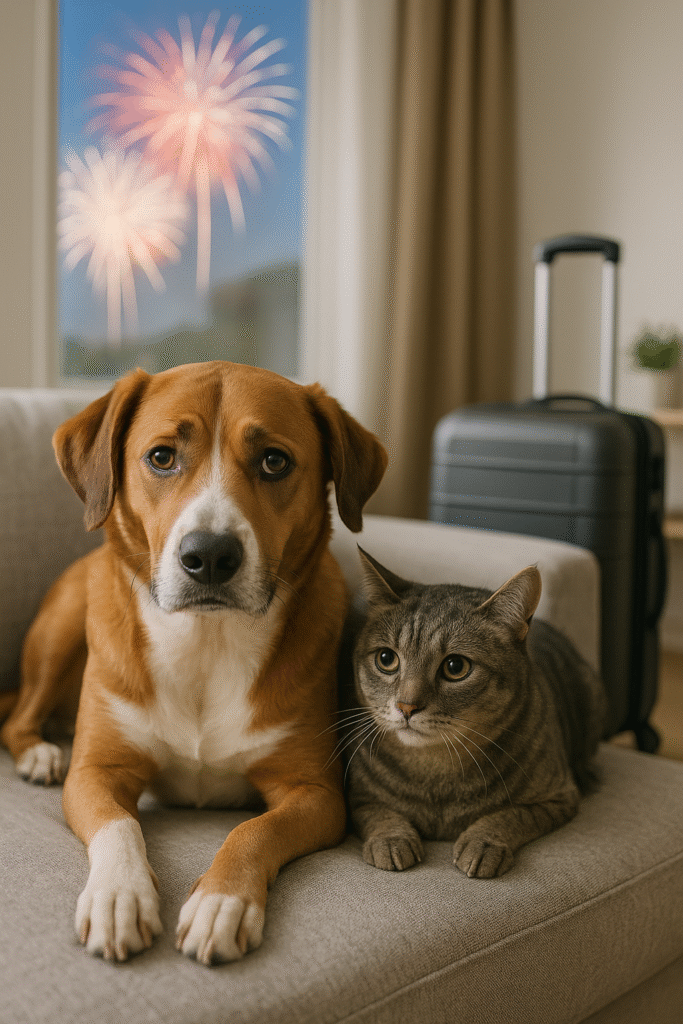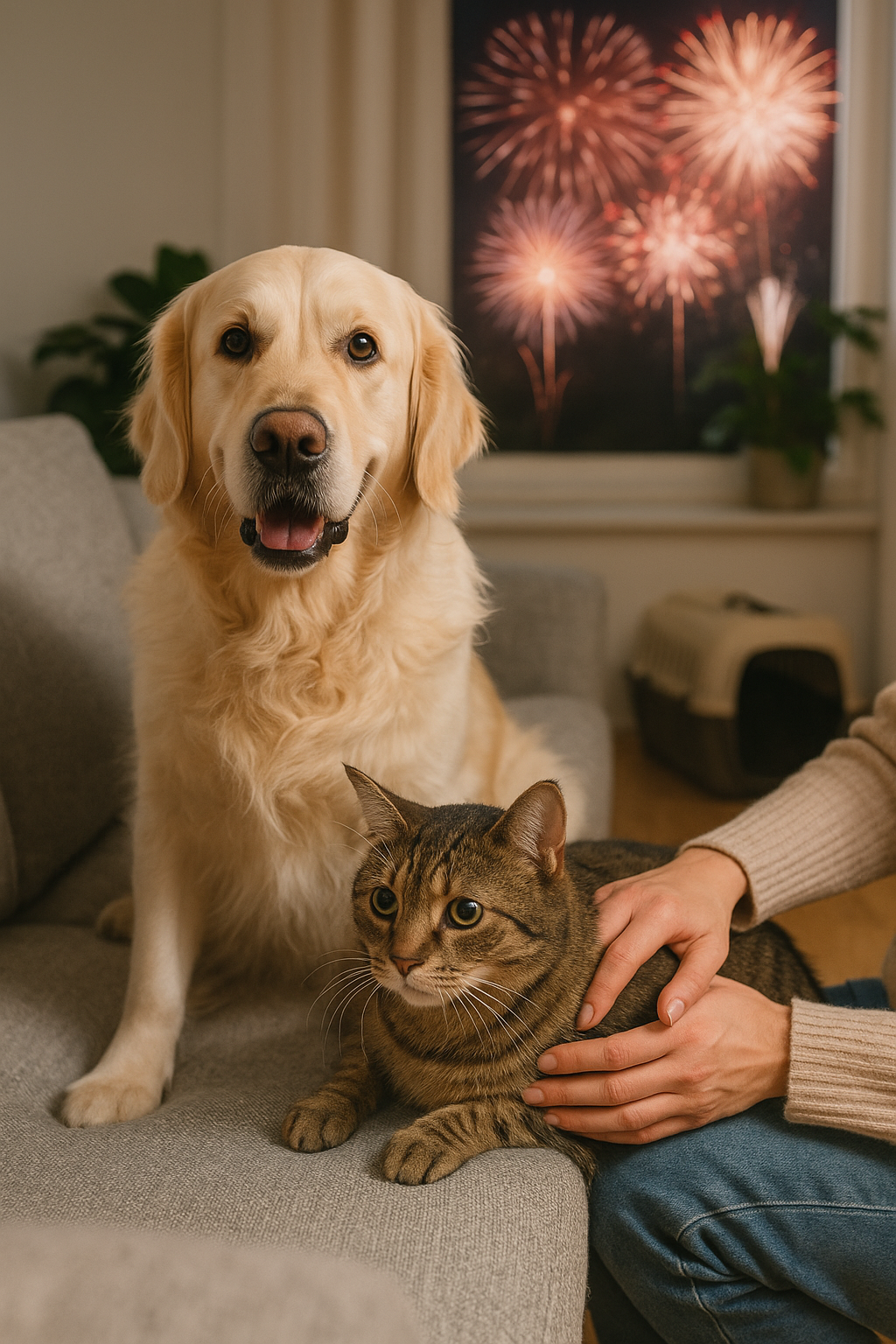Pet Anxiety: Proven Strategies to Calm Your Dog and Cat During Fireworks, Travel & Vet Visits
“Is your furry friend trembling at the first boom of fireworks? Does your cat panic in the carrier? You’re not alone—Pet Anxiety is real, but these simple, vet-backed techniques will help your companion feel safe and relaxed.”

Why Pet Anxiety Happens
Before diving into solutions, let’s understand why pets get anxious:
- Loud Noises & Flashing Lights
- Fireworks, thunder, construction, even a car backfiring can trigger a fear response.
- Unfamiliar Environments
- Car rides, hotel rooms, or an unfamiliar vet’s office can make pets feel insecure.
- Past Negative Experiences
- A traumatic vet procedure or a scary storm can leave long-lasting associations with fear.
- Separation & Change
- Moving homes, new roommates, or leaving the house for extended periods can spark stress.
Tip: Watch your pet’s body language—pacing, panting, drooling, hiding, or destructive chewing all signal stress.
1. Calming Your Pet During Fireworks (July 4th, Bonfire Night & Beyond)
A. Pre-Event Preparation
- Plan Ahead: Check local fireworks schedules. In the UK, see official guidance on fireworks safety at gov.uk/firework-safety. In the US, the Consumer Product Safety Commission offers tips at CPSC Fireworks & Pet Safety.
- Create a Safe Space: Choose a quiet room or closet, line it with your pet’s favorite bedding, toys, and an unwashed t-shirt with your scent.
- Sound Masking: Play white noise, classical music, or turn on the TV at a low volume to drown out bangs.
B. Day-Of DIY Hacks
- Window & Door Security
- Close windows, doors, and block off cat-flaps.
- Darken the Room
- Draw curtains or blackout shades to reduce flashing lights.
- Pressure Wraps
- A snug-fitting “Thundershirt” or DIY wrap (use a soft t-shirt) can provide comforting, constant pressure.
- Pheromone Sprays & Diffusers
- Dog Appeasing Pheromone (DAP) like Adaptil for dogs or Feliway for cats can ease nerves—spray bedding 30 minutes before noise starts.
DIY Tip: Make your own anxiety wrap by cutting the sleeves off an old cotton tee, wrapping snugly around the chest (not too tight—should be one to two fingers’ space), and securing with velcro.
C. When to Seek Professional Help
- If your pet’s anxiety is severe—pacing nonstop, refusing food, or self-harming—consult your vet about short-term prescription options like low-dose trazodone.
2. Stress-Free Travel with Your Pet
A. Preparing for the Journey
- Gradual Crate Training
- Weeks before travel, leave the crate out with cozy bedding and treats—feed meals inside to build positive association.
- Short Practice Trips
- Start with 5–10 minute car rides, gradually increasing to simulate travel day length.
- Comfort Items
- Pack your pet’s favorite toys, blanket, and a worn item of your clothing.
B. On the Road Solutions
- Secure Carrier: Place crate on a flat surface—back seat floorboard or strapped with a seatbelt.
- Temperature & Ventilation: Never leave pets unattended in a hot or cold car—always ensure airflow.
- Frequent Breaks: Stop every 2–3 hours. Offer water, a walk on a leash, and a quick comfort break.
- Calming Aids: Consider all-natural supplements like L-theanine chews (e.g., Solliquin) 30 minutes before departure.
Pro Tip: Spray the carrier interior with calming pheromones 15 minutes before placing your pet inside.

3. Making Vet Visits Low-Stress
A. The Home-Vet Connection
- Familiar Items: Bring a favorite toy or blanket that smells like home.
- Carrier Comfort: Leave the carrier out at home with treats inside so it’s seen as a positive place.
B. At the Clinic
- Quiet Waiting Areas
- Choose clinics that offer separate cat and dog waiting rooms or ask to wait in your car until called.
- Low-Stress Handling
- Look for practices certified in the Fear Free™ approach—veterinarians trained to reduce anxiety.
- Reward-Based Exams
- Ask your vet to use treats throughout exam, not just at the end.
DIY Muzzle: For short procedures, you can make a soft muzzle from gauze—wrap loosely under the chin and over the nose, tying gently behind the ears (consult your vet first).
4. Product Recommendations
| Situation | Product Type | Examples & Where to Buy |
|---|---|---|
| Noise | Thundershirt® | thundershirt.com |
| Pheromone Diffuser | Adaptil, Feliway (Amazon, Chewy) | |
| Travel | Calming Chews | Solliquin™ (Vet supply) |
| Seatbelt Harness | Kurgo Tru-Fit (REI, Petco) | |
| Vet Visit | Cat Calming Cap | Comfy Cone™ (Veterinary clinics, Chewy) |
| All-Purpose | CBD Oil (pets) | Holistapet, Honest Paws (ensure <0.3% THC) |
5. Global & Regional Resources
- United States
- Fireworks & Pet Safety: CPSC Guide
- Animal Health Regulations: FDA Animal & Veterinary
- United Kingdom
- Firework Safety: gov.uk/firework-safety
- Traveling with Pets: gov.uk/bring-pet-to-uk
- Canada & Australia
- Canadian Veterinary Behaviour Specialists: cvbc.ca
- Firework Advice (Australia): State by state—check your local council’s website
- Europe & Asia
- European Pet Anxiety Network: epanet.eu
- India—Pet Travel Guidelines: ICAR NIVEDI
For more holistic pet-care inspiration, check out these vet-approved recipe ideas on TrenBuzz:
👉 Healthy Homemade Pet Food Recipes: Vet-Approved Recipes for Dogs and Cats
Interactive Q&A Corner
- What’s your pet’s funniest reaction to thunder?
Share in the comments to help other readers see they’re not alone! - Which DIY hack worked best?
Let us know—your tip could be featured in our next update.
Wrapping Up
Pet Anxiety affects countless households, but a few thoughtful preparations and tools can transform fear into calm. Remember: every pet is unique. What works for one may need tweaking for another. Always observe your companion’s response, and don’t hesitate to enlist professional guidance when needed.
You’ve got this—with patience, love, and a sprinkle of creativity, your pet will learn that even the loudest bangs and the wiggliest carriers can be no match for your care. 🐾
Further Reading & Support
- U.S. Consumer Product Safety Commission: Fireworks and Pet Safety
- UK Government: Firework Safety Guidance
- TrenBuzz Vet-Approved Diets: Homemade Pet Food Recipes
Disclaimer: The information provided in this blog is for educational and informational purposes only and should not be considered veterinary advice. Always consult a qualified veterinarian before making any changes to your pet’s care or using any products or techniques mentioned herein. The author and publisher are not responsible for any adverse effects or consequences resulting from the use of any tips, techniques, or products discussed in this article. All images used in this article are royalty‑free or licensed for commercial use and are provided here for illustrative purposes.
Happy calming!
— Your Friendly Pet-Care Blogger
